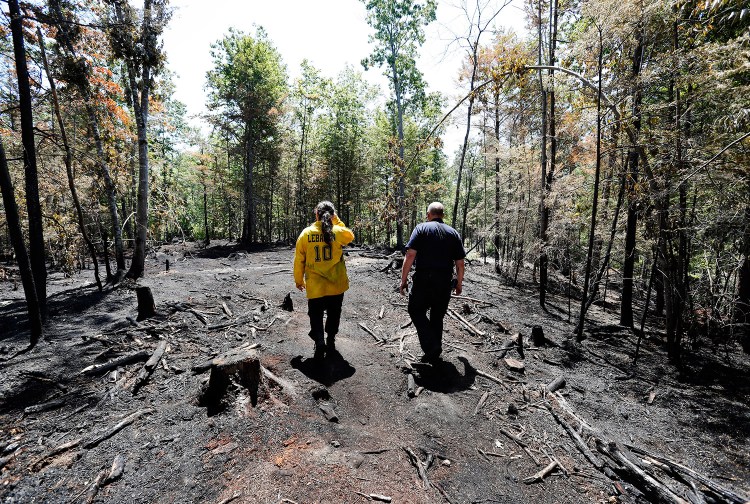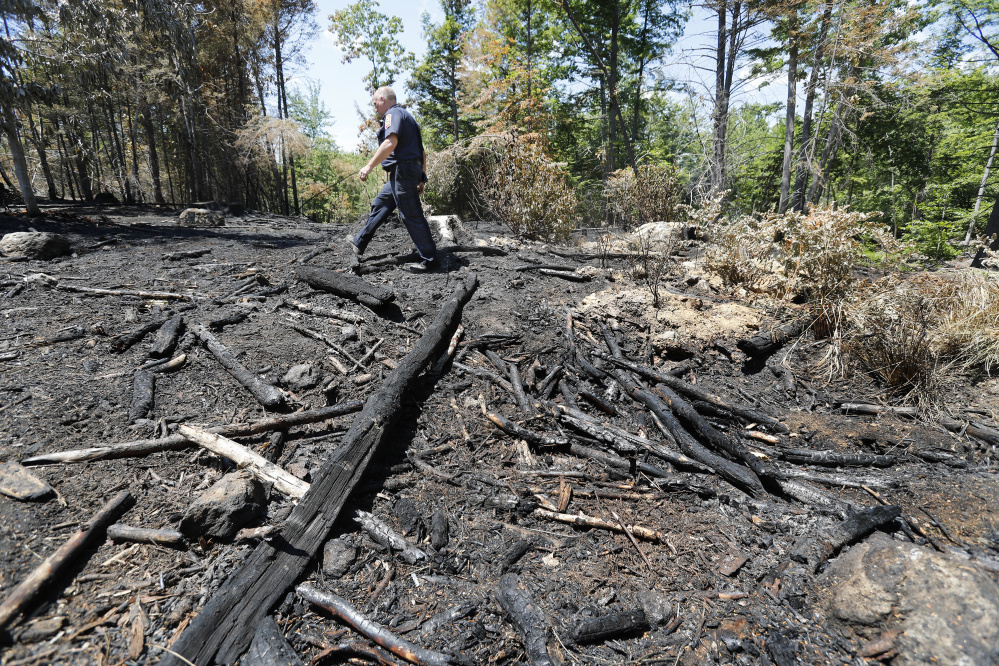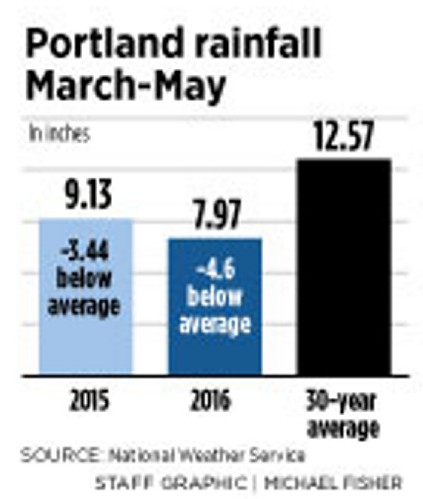LEBANON — Southern Maine saw an abnormally dry spring with significantly less rainfall than the long-term average, and that is bringing more ground fires earlier in the year, fire officials said.
The Portland area is significantly drier this spring than usual, according to data from the National Weather Service.
In March, April and May, 7.97 inches of rain fell in Portland. That’s 4.60 inches, or roughly 37 percent, below the 30-year average of 12.57 inches in that period. In the same three months last year, 9.13 inches fell on Portland, or 3.44 inches (27 percent) below the 30-year average. And much of York County is currently in the midst of moderate drought conditions, according to the U.S. Drought Monitor.
That means more ground fires, which start below the topsoil when flames from a lightning strike or another wildfire reach flammable peat or root systems. This year they are showing up two to three months early, said Maine Forest Service Ranger Matt Gomes.
That was the case in Lebanon, where fire crews from Lebanon and surrounding towns fought a three-alarm wildfire that burned through an area of logging slash that already had begun to turn into peat. After much of the visible flames were extinguished Friday, firefighters returned over the weekend because the fire was still burning below the surface.
“Because of these conditions, we’ll be putting out hot spots for days,” said Lebanon Fire Chief Dan Meehan, who checked the fire scene again Monday, only to find new areas of peat smoldering in the sunshine. Meehan can only keep returning to the remote fire site to check each day – and pray for rain.
Meteorologists say he may be out of luck this week. Besides a slight chance of thunderstorms between Monday and Tuesday, the next chance of rain is Thursday, said weather service meteorologist Eric Schwibs.
Temperatures will remain in the 70s or low 80s through at least Thursday, Schwibs said.
Meehan did not know how the Lebanon fire began, and said forest rangers will investigate the cause.
At the scene Monday, about 3.8 acres had been consumed, mostly in an area that had been logged a few years ago. A 3-foot layer of dry, rotting timber created a hotbed for fire activity.
Flames in the area about half a mile off T.M. Wentworth Road were first reported Friday by a passing pilot in a small plane. Although the cause was not known yet, Meehan said crews found a discarded cigarette lighter in the burned area, and signs that someone had been camping nearby illegally.
“It could have been burning for a day or a few hours” before the fire was found, Meehan said.
Ground fires typically do not flare up until August and September after the hottest and driest months, Gomes said. But this year is different. A warm winter with little snow meant less residual moisture left in the soil. Combined with less spring rain, that means conditions are ripe for ground fires.
“Typically in the spring, our ground is much more saturated,” Gomes said. “This year is the odd year out because of the dry spring and the lack of snow cover this winter. We are getting ground fires earlier in the year than we typically have been.”
Once the flames go subterranean, they can be very difficult to find and even harder to fully extinguish. Crews must dig through the soil to find the burning material, like miners following a vein of ore.
“It moves very, very slowly, because of the limited oxygen,” Gomes said. “(The fire) will sit in that root system for a week until it burns itself up to the surface and then it takes off.”
Fire crews also deploy a fire-fighting foam, which helps the water soak into the ground and penetrate deeper to reach burning material.
Conditions also are dry in central Maine, where fire departments are being extra vigilant with burn permits, and at least one department is considering new rules to prevent fires caused by cigarette butts thrown into dry landscaping mulch.
In Skowhegan, Fire Chief Shawn Howard said his department has been monitoring burn permits closely and doesn’t issue them if the wind is greater than 7 mph or the fire danger rating is Class 3 or above. Class 1 is the lowest danger and Class 5 is the highest.
“Things have greened up nice, which does help, but it’s super dry and people need to be extremely cautious,” Howard said.
Mulch fires have been keeping the Augusta Fire Department busy, said Chief Roger Audette, who is considering looking at ordinances that would make businesses accountable.
“Our biggest problem is the retail shopping centers that put down the mulch for decorative purposes,” Audette said. “We are constantly going to a lot of these places because people flick their cigarettes in there and then the areas are smoldering. This stuff is basically fuel. We go out daily.”
According to the U.S. Drought Monitor, about 30 percent of the state saw abnormally dry or moderate drought conditions as of last week, compared with the week before, when about 21 percent of the state was seeing drier conditions than normal. Most of the driest areas were in York and Cumberland counties.
Send questions/comments to the editors.






Success. Please wait for the page to reload. If the page does not reload within 5 seconds, please refresh the page.
Enter your email and password to access comments.
Hi, to comment on stories you must . This profile is in addition to your subscription and website login.
Already have a commenting profile? .
Invalid username/password.
Please check your email to confirm and complete your registration.
Only subscribers are eligible to post comments. Please subscribe or login first for digital access. Here’s why.
Use the form below to reset your password. When you've submitted your account email, we will send an email with a reset code.